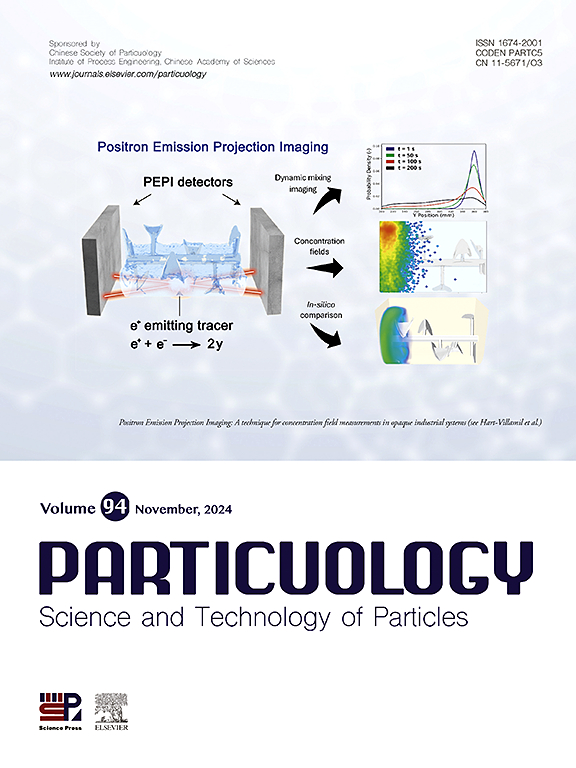颗粒非球形和界面粗糙度对土-结构界面剪切特性耦合影响的DEM研究
IF 4.1
2区 材料科学
Q2 ENGINEERING, CHEMICAL
引用次数: 0
摘要
土-结构界面在土工结构中很常见,了解其抗剪特性对有效设计至关重要。然而,颗粒形状和界面粗糙度对SSI的耦合效应尚未得到充分研究。本研究通过采用五种不同非球面(η)值的超椭球粒子来模拟非球形粒子,解决了这一空白。采用离散元法(DEM)进行了不同粗糙度(Rn)的界面剪切试验。结果表明,η和Rn对土体抗剪强度、局部剪切带厚度和土体结构均有显著影响,存在单因素主导和双因素交互作用两种耦合效应。对配位数(Cn)和归一化接触力概率分布的影响更为直观。具体来说,非球形粒子由于联锁增强而表现出更高的初始Cn,而Rn的影响较小。界面处归一化接触力与纯土相似,呈指数分布,与η和Rn无关。值得注意的是,剪切带被划分为三个相等的部分,用于土壤结构分析。这些发现为SSI提供了新的见解,有助于更有效和更安全的岩土工程设计。本文章由计算机程序翻译,如有差异,请以英文原文为准。

DEM investigation into the coupling effects of particle asphericity and interface roughness on shear behaviour of soil-structure interface
Soil-structure interfaces (SSI) are common in geotechnical structures, and understanding their shear behavior is essential for effective design. However, the coupling effects of particle shape and interface roughness on SSI remain understudied. This study addresses this gap by employing five types of super-ellipsoid particles with varying asphericity (η) values to model non-spherical particles. Interface shear tests with different roughness levels (Rn) were conducted using Discrete Element Method (DEM) simulations. The results show that both η and Rn significantly influence shear strength, localized shear band thickness, and soil fabric, with two types of coupling effects: single-factor dominance and double-factor interaction. The influence on coordination number (Cn) and probability distribution of normalized contact force is more straightforward. Specifically, non-spherical particles exhibit a higher initial Cn due to enhanced interlocking, while Rn has a lesser impact. The normalized contact force at the interface follows an exponential distribution, similar to pure soil, and is largely independent of η and Rn. Notably, the shear zone is divided into three equal parts for soil fabric analysis. These findings offer new insights into SSI, contributing to more effective and safer geotechnical designs.
求助全文
通过发布文献求助,成功后即可免费获取论文全文。
去求助
来源期刊

Particuology
工程技术-材料科学:综合
CiteScore
6.70
自引率
2.90%
发文量
1730
审稿时长
32 days
期刊介绍:
The word ‘particuology’ was coined to parallel the discipline for the science and technology of particles.
Particuology is an interdisciplinary journal that publishes frontier research articles and critical reviews on the discovery, formulation and engineering of particulate materials, processes and systems. It especially welcomes contributions utilising advanced theoretical, modelling and measurement methods to enable the discovery and creation of new particulate materials, and the manufacturing of functional particulate-based products, such as sensors.
Papers are handled by Thematic Editors who oversee contributions from specific subject fields. These fields are classified into: Particle Synthesis and Modification; Particle Characterization and Measurement; Granular Systems and Bulk Solids Technology; Fluidization and Particle-Fluid Systems; Aerosols; and Applications of Particle Technology.
Key topics concerning the creation and processing of particulates include:
-Modelling and simulation of particle formation, collective behaviour of particles and systems for particle production over a broad spectrum of length scales
-Mining of experimental data for particle synthesis and surface properties to facilitate the creation of new materials and processes
-Particle design and preparation including controlled response and sensing functionalities in formation, delivery systems and biological systems, etc.
-Experimental and computational methods for visualization and analysis of particulate system.
These topics are broadly relevant to the production of materials, pharmaceuticals and food, and to the conversion of energy resources to fuels and protection of the environment.
 求助内容:
求助内容: 应助结果提醒方式:
应助结果提醒方式:


